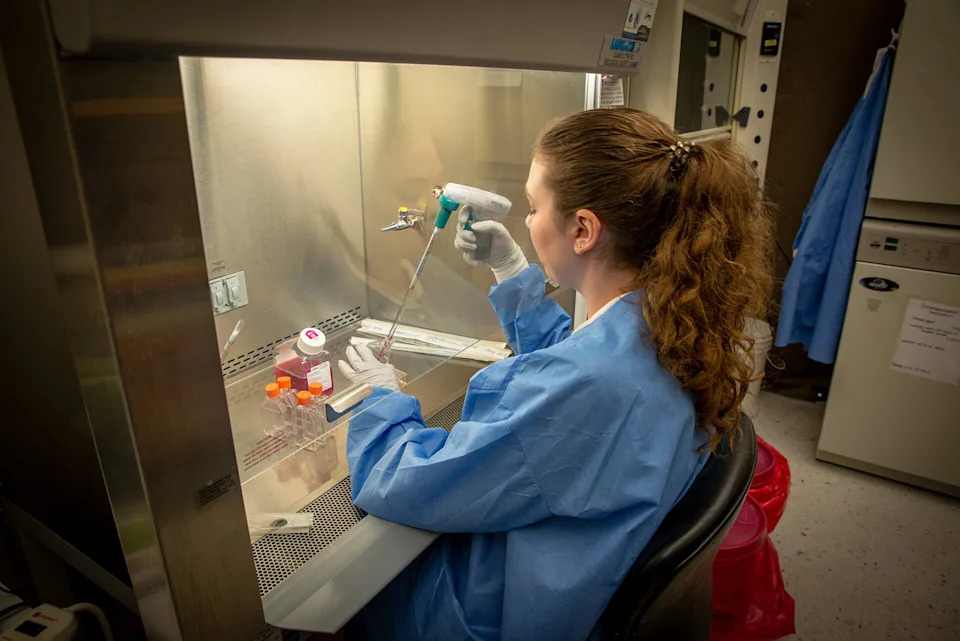Pepper the cat is at it again. After his hunting skills helped virologists identify the first jeilongvirus in the United States, the virus-hunting feline has detected a new strain orthoreovirus.
It helps that Pepper’s owner is John Lednicky, a virologist at the University of Florida College of Public Health. Pepper caught an Everglades short-tailed shrew and Lednicky took the small mole-lake mammal into the lab for testing. Lednicky’s research includes studying the mule deerpox virus, so he wanted to look at the shrew specimen for any clues to how this virus is transmitted among mammals.
It turns out that the shrew had a strain of orthoreovirus. The viruses in this genus infect several mammal species, including white-tailed deer, bats, and humans. Their effects on humans are not very well understood, but there are rare reports that orthoreoviruses may be associated with cases of encephalitis, meningitis, and gastroenteritis in children.
“The bottom line is we need to pay attention to orthoreoviruses, and know how to rapidly detect them,” Lednicky said in a statement.
[ Related: The deadliest viruses in human history, from COVID to smallpox. ]
“There are many different mammalian orthoreoviruses and not enough is known about this recently identified virus to be concerned,” study co-author and UF Ph.D. candidate Emily DeRuyter added. “Mammalian orthoreoviruses were originally considered to be ‘orphan’ viruses, present in mammals including humans, but not associated with diseases. More recently, they have been implicated in respiratory, central nervous system and gastrointestinal diseases.”
The complete genomic coding sequences for this new virus, officially named “Gainesville shrew mammalian orthoreovirus type 3 strain UF-1,” was recently published in the journal Microbiology Resource Announcements.
Importantly, Pepper has shown no signs of illness, according to Lednicky.
“This was an opportunistic study,” Lednicky said. “If you come across a dead animal, why not test it instead of just burying it? There is a lot of information that can be gained.”
 Emily DeRuyter, lead author on a paper describing the discovery of a new strain of orthoreovirus, tends to cells in the biosafety cabinet of the John Lednicky lab. CREDIT: Photo by Andy Williams.
Emily DeRuyter, lead author on a paper describing the discovery of a new strain of orthoreovirus, tends to cells in the biosafety cabinet of the John Lednicky lab. CREDIT: Photo by Andy Williams.Probing mice for pathogens
In 2024, Pepper helped detect the first jeilongvirus in the US. He dropped a dead mouse on the carpet at Lednicky’s feet, which was also taken into the lab for testing. Jeilongvirus was previously found in Asia, Africa, South America, and Europe. Unlike orthoreoviruses, it is known to infect more than just mammals, and can make reptiles, fish, and birds sick. It can also occasionally cause serious illness in humans.
The virus in the mouse that Pepper found was genetically different from other jeilongviruses and is designated as “Gainesville rodent jeilong virus 1.” According to Lednicky, it grows equally well in rodent, human, and nonhuman primate cells, “making it a great candidate for a spillover event,” or when one virus spills from one species into another.
The team also recently found two novel viruses in farmed white-tailed deer. Since viruses are constantly evolving and lab techniques have gotten more sophisticated, Lednicky said finding new viruses isn’t entirely surprising.
“I’m not the first one to say this, but essentially, if you look, you’ll find, and that’s why we keep finding all these new viruses,” Lednicky said.
[ Related: Finland finds its first giant virus. ]
An influenza-like virus
Two different types of orthoreovirus can infect a host cell, similar to influenza. This two-pronged infection essentially creates a new virus by mixing and matching the genes, according to Lednicky.
In 2019, this same team isolated the first orthoreovirus found in a deer. That first strain’s genes were nearly identical to an orthoreovirus detected in farmed mink in China and a very sick lion in Japan. Scientists were incredibly puzzled how the same hybrid virus could pop up in farmed deer in Florida and two carnivore species thousands of miles away. Some speculated that components of the animals’ feed may have come from the same manufacturer.
More research is needed to fully understand how orthoreoviruses move around and are transmitted, their prevalence in humans, and how sick they could make people. Future serology and immunology studies could help the team better understand the threat of orthoreoviruses including the one a black cat helped scientists find.














